In accordance with the Employment Act of 1946, the purpose of this Report is to provide the U.S. Congress with “timely and authoritative information concerning economic developments and economic trends” for the preceding year and, prospectively, for the years ahead. As required by the Employment Act, the Report also sets forth the Administration’s program for achieving the chartered purpose of:
Creating and maintaining, in a manner calculated to foster and promote free competitive enterprise and the general welfare, conditions under which there will be afforded useful employment opportunities, including self-employment, for those able, willing, and seeking to work, and to promote maximum employment, production, and purchasing power (79th U.S. Congress, 1946).
In the 10 chapters that constitute this Report, we present evidence that the Trump Administration’s policy actions and priorities are thus far delivering economic results consistent with the 1946 mandate.
For the second consecutive year, the U.S. economy outperformed expectations and broke from recent trends by a substantial margin. In June 2017, the Congressional Budget Office projected that during the four quarters of 2018, real gross domestic product (GDP) would grow by 2.0 percent, the unemployment rate would decline by 0.1 percentage point, to 4.2 percent, and employment growth would average 107,000 jobs per month. Instead, real GDP in the first three quarters of 2018 grew at a compound annual rate of 3.2 percent—above the Trump Administration’s own Q4-over-Q4 forecast for the second successive year—the unemployment rate declined by 0.4 percentage point, to a near-50-year low of 3.7 percent, and employment growth averaged 223,000 jobs per month. Growth in labor productivity, which averaged just 1.0 percent between 2009:Q3 and 2016:Q4, doubled to 2.0 percent in 2018. Capital expenditures by nonfinancial businesses rose 13.9 percent at a compound annual rate through 2018:Q3.
The strong economic performance in 2017 and 2018 was not merely a continuation of trends already under way during the postrecession expansion, but rather constituted a distinct break from the previous pace of economic and employment growth since the start of the current expansion in 2009:Q3. Consistent with conclusions in the 2018 Economic Report of the President, investment, manufacturing employment, worker compensation, and new startups have all risen sharply in the two years since the 2016 election.
In addition, overall economic output by the third quarter of 2018 was $250 billion, or 1.3 percent, larger than projected by the 2009:Q3–2016:Q4 trend, with the compound annual growth rate up 1.2 percentage points over trend. Higher output growth was driven by a marked rise in real private investment in fixed assets, which was 10.6 percent over the trend as of the third quarter. In the first three quarters of 2018, the contribution of real private nonresidential fixed investment to GDP growth rose from 0.6 percentage point, the average of the preceding expansion, to 1.0 percentage point, while investment as a share of GDP rose to its second-highest level for any calendar year since 2001. Real private nonresidential fixed investment by nonfinancial businesses rose 8.3 percent at a compound annual rate through 2018:Q3, climbing to a level 14.7 percent above that projected by the 2009:Q3–2016:Q4 trend. As of December 2018, average nominal weekly earnings of goods producing production and nonsupervisory workers had risen $2,300 above trend on an annualized basis.
In the chapters that follow, we demonstrate that these departures from the recent trend are not accidental but rather reflect the Trump Administration’s deliberate measures to create and maintain conditions under which the U.S. economy can achieve maximum employment, production, and purchasing power. Specifically, a unifying theme throughout this Report is that these conditions are generally achieved by providing maximum scope for the efficiency of free enterprise and competitive market mechanisms, and ensuring that those mechanisms are operative in both domestic and global markets.
Beginning with chapter 1, “Evaluating the Effects of the Tax Cuts and Jobs Act,” we use currently available data to examine the Tax Cuts and Jobs Act’s (TCJA’s) anticipated and observed effects, with particular attention to the relative velocities of adjustment along each economic margin. We find that by lowering the cost of capital, the TCJA had an instant and large effect on business expectations, with firms immediately responding to the TCJA by upwardly revising planned capital expenditures, employee compensation, and hiring. We also observe revised capital plans translating into higher capital expenditures and real private investment in fixed assets, with nonresidential investment in equipment, structures, and intellectual property products growing at a weighted average annual rate of about 8 percent from 2017:Q4 through 2018:Q3, climbing to $150 billion over the pre-TCJA expansion trend of 2009:Q3 through 2017:Q4. (Equipment investment trends are calculated through 2017:Q3, because the TCJA’s allowance of full expensing of new equipment investment was retroactive to September 2017.) In addition to tallying more than 6 million workers receiving bonuses directly attributed to the TCJA, with an average bonus size of $1,200, we also estimate, real disposable personal income per household rose to $640 over the trend by the third quarter of 2018, or 16 percent of the CEA’s estimated long-run effect of $4,000 per household. In real terms, median usual weekly earnings of all full-time wage and salary workers were up $805 over trend on an annualized basis.
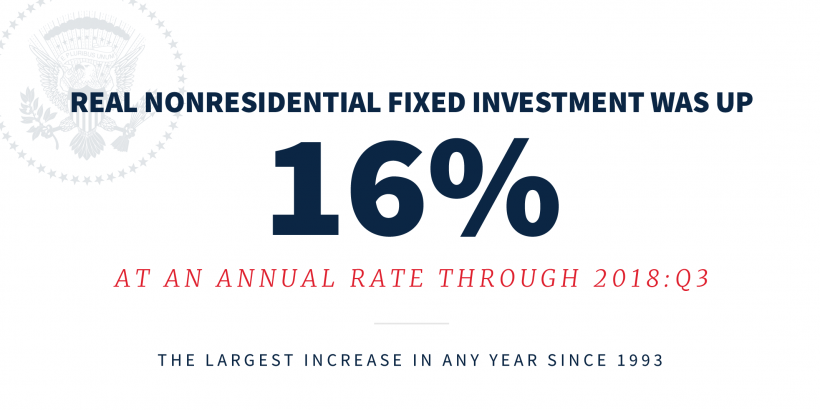
We also report evidence of a reorientation of U.S. investment from direct investment abroad to investment in the United States, as the TCJA attenuated incentives to shift productive assets and profits to lower-tax jurisdictions. Specifically, in the first three quarters after the TCJA’s enactment, U.S. direct investment abroad declined by $148 billion, while the United States’ direct investment position in eight identified tax havens declined by $200 billion. Based on extensive evidence from a large body of corporate finance literature, we conclude that shareholder distributions through share repurchases are an important margin of adjustment to a simultaneous positive shock to cash flow and investment, constituting the primary mechanism whereby efficient capital markets reallocate capital from mature, cash-abundant firms without profitable investment opportunities to emerging, cash-constrained firms with profitable investment opportunities.
In chapter 2, “Reducing the Burden of Regulatory Costs,” we examine the Administration’s important deregulatory efforts, which have also led to improved performance over the previous two years. We develop a framework to analyze the cumulative economic impact of regulatory actions on the U.S. economy. As the first Administration to use regulatory cost caps to reduce the cumulative burden of Federal regulation, the Trump Administration in 2017 and 2018 issued more deregulatory actions than regulatory actions and reversed the long-standing trend of rising regulatory costs. By raising the cost of conducting business, regulation can prevent valuable business and consumer activities.
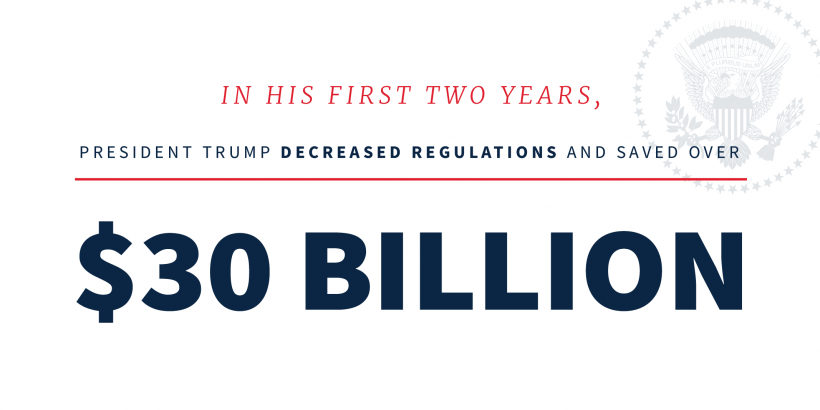
More important, however, we also stress that regulations in one industry affect not only the regulated industry or sector but also the economy as a whole. We find that this implies that official measures understate regulatory costs and therefore also understate the regulatory cost savings of the Trump Administration’s regulatory reforms because they do not account for relevant opportunity costs, especially those accruing outside the regulated industry. The official data show that from 2000 through 2016, the annual trend was for regulatory costs to grow by an average of $8.2 billion each year. In contrast, in 2017 and 2018 Federal agencies took deregulatory actions that resulted in costs savings that more than offset the costs of new regulatory actions. The official data show that in fiscal year 2017, the deregulatory actions saved $0.6 billion in annualized regulatory costs (with a net present value of $8.1 billion); and in fiscal year 2018, the deregulatory actions saved $1.4 billion in annualized regulatory costs (with a net present value of $23 billion). Looking at just three important deregulatory case studies, the CEA calculates that the three actions will reduce annual regulatory costs by an additional $27 billion.
Chapter 3, “Expanding Labor Force Opportunities for Every American,” discusses the dramatic effect the revival of the economy has had on labor markets. Consistent with the robust pace of economic growth in the United States, the labor market is the strongest that it has been in decades, with an unemployment rate that remained under 4 percent for much of 2018. Employment is expanding and wages are rising at their fastest pace since 2009. Whenever both quantity and price go up in a market, this must be partly driven by a rise in demand. This suggests that an important change in the labor market has been an increase in the demand for labor, induced potentially by a supply-side expansion enabled by tax reform and deregulation. Although the low unemployment rate is a signal of a strong labor market, there is a question as to whether the rapid pace of hiring can continue and whether there are a sufficient number of remaining potential workers to support continued economic growth. This pessimistic view of the economy’s potential, however, overlooks the extent to which the share of prime-age adults who are in the labor market remains below its historical norm.
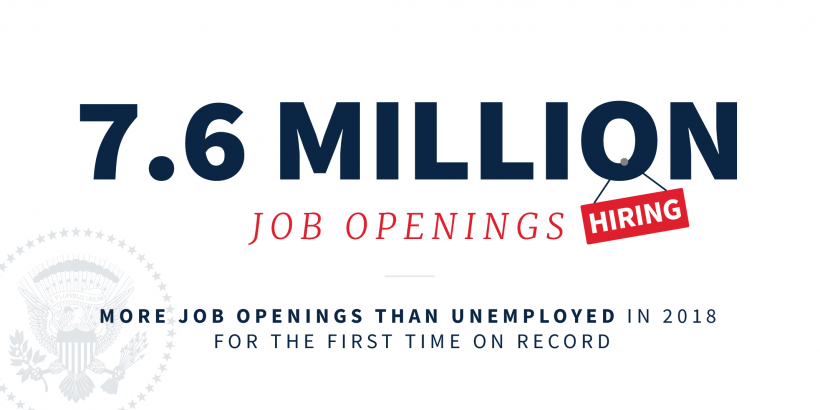
As is explored in chapter 3, potential workers could be drawn back into the labor market through Administration policies designed to reduce past tax and regulatory distortions and to encourage additional people to engage in the labor market. Policies examined in this chapter that intend to increase labor force participation include reducing the costs of child care, working with the private sector to increase employer training and reskilling initiatives, and pursuing criminal justice reform to increase labor force engagement among affected communities. We also highlight the potential benefits of reducing occupational licensing, and incentivizing investment in designated Opportunity Zones to improve economically distressed areas, as provided for in the TCJA.
In chapter 4, “Enabling Choice and Competition in Healthcare Markets,” we seek to address the 1946 mandate for this Report to analyze how to “foster and promote free and competitive enterprise” to a greater extent in the U.S. healthcare sector. We discuss the rationales commonly offered for government intervention in healthcare and explain why such interventions often, and unnecessarily, restrict choice and competition, demonstrating that the resulting government failures are frequently more costly than the market failures they attempt to correct. In light of recent public proposals to dramatically increase government intervention in healthcare markets, such as “Medicare for All,” we also analyze how these proposals eliminate or decrease choice and competition. As a result, we find that these proposals would be inefficient, costly, and likely reduce, as opposed to increase, the population’s health. Funding them would create large distortions in the economy, with the universal nature of “Medicare for All” constituting a particularly inefficient way to finance healthcare for lower- and middle- income people.
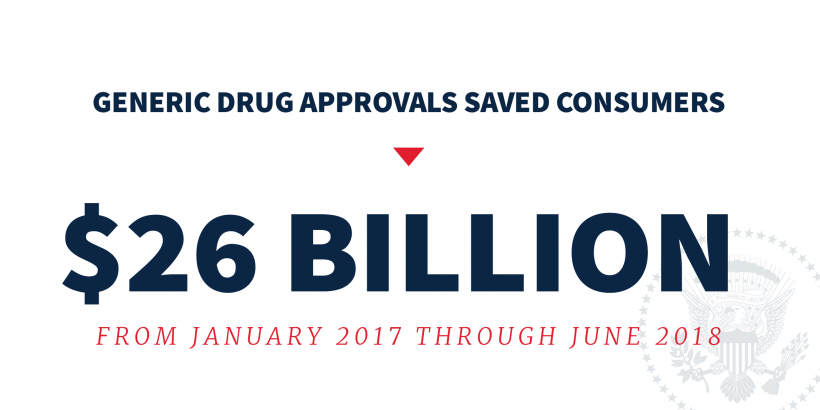
We contrast such proposals with the Trump Administration’s actions that are increasing healthcare choice and competition for healthcare. We focus on the elimination of the Affordable Care Act’s individual mandate penalty, which will enable consumers to decide for themselves what value they attach to purchasing insurance and which we project will generate $204 billion in value over 10 years. Expanding the availability of association health plans and short-term, limited-duration health plans will increase consumer choice and insurance affordability. We find that taken together, these three sets of actions will generate a value of $453 billion over the next decade. On the pharmaceutical front, the Food and Drug Administration is increasing price competition by streamlining the drug application and review process at the same time that record numbers of generic drugs are being approved, price growth is falling, and consumers have already saved $26 billion through the first year and a half of the Administration. In addition, the influx of new, brand name drugs resulted in an estimated $43 billion in annual benefits to consumers in 2018.
Chapter 5, “Unleashing the Power of American Energy,” discusses the important role of energy markets in the new economic revival and the Administration’s goal of stimulating free market innovation to enable U.S. energy independence. Coal production stabilized in 2017 and 2018 after a period of contraction in 2015 and 2016. The United States is now a net exporter of natural gas for the first time in 60 years, and petroleum exports are increasing at a pace that suggests positive net exports by 2020. Taking advantage of America’s abundant energy resources is a key tenet of the Trump Administration’s plan for long-term economic growth as well as national security. This is best achieved by recognizing that price incentives and the role of technological innovation—which is guided by the price incentive in a market economy like that of the United States—are critical for understanding the production of both renewable natural resources and nonrenewable natural resources like petroleum.

By enabling domestic production, the Administration seeks to facilitate the evolution of the U.S. economy’s role in global markets. Since the President took office, the U.S. fossil fuels sector has set production records. These were led by technological improvements, tax changes that lowered the cost of investing in mining structures, elevated global prices, and deregulatory actions that raised the expected returns of energy projects. Chapter 5 documents 65 deregulatory actions affecting the energy sector that were completed through the end of fiscal year 2018, with projected present value savings of over $5 billion.
In chapter 6, “Ensuring a Balanced Financial Regulatory Landscape,” we revisit the causes and consequences of, and responses to, the financial crisis of 2008. In particular, we identify that the absence of actuarially fair pricing of implicit government guarantees of financial institutions and markets was a major factor exacerbating the crisis. Unfortunately, we also find that the salient legislative response to the crisis—the 2010 Dodd-Frank Act—not only failed to resolve this flaw but also excessively raised regulatory complexity, with the increased cost of compliance falling disproportionately on small and midsized financial institutions, which account for a disproportionate share of commercial and industrial lending to small and medium-sized enterprises.
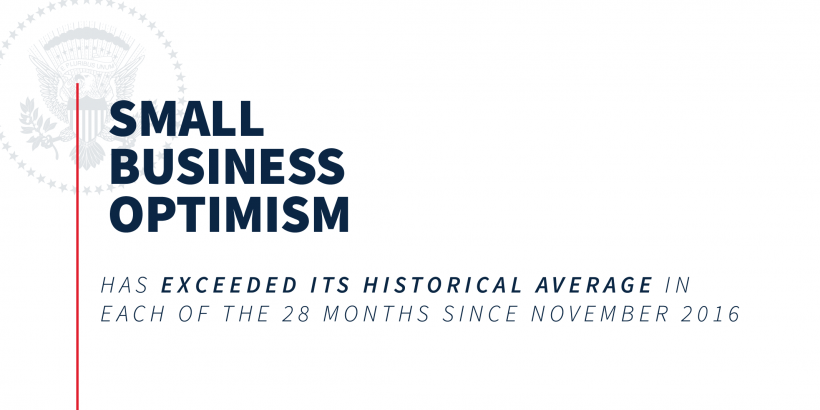
In addition to articulating the Administration’s approach to achieving the Seven Core Principles for financial regulation, established by Executive Order 13772, chapter 6 also demonstrates how the Economic Growth, Regulatory Relief, and Consumer Protection Act of 2018 released small and medium-sized banks from the more restrictive provisions of Dodd-Frank, while preserving heightened regulatory oversight of genuinely systemically important financial institutions.
Again reflecting the CEA’s 1946 mandate to evaluate “current and foreseeable trends in the levels of employment, production, and purchasing power,” chapter 7, “Adapting to Technological Change with Artificial Intelligence while Mitigating Cyber Threats,” analyzes how technological change in information technology is likely to affect future U.S. labor markets. We begin by reviewing the latest developments in artificial intelligence (AI) and automation, concluding that a narrow, static focus on possible job losses leads to a misleading picture of the likely effects of AI on the Nation’s economic well-being. Technological advances might eliminate specific jobs, but they do not generally eliminate work, and over time they will likely greatly increase real wages, national income, and prosperity.
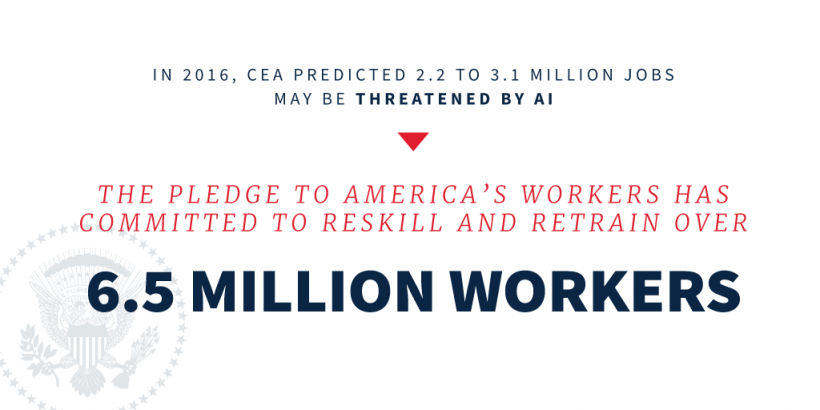
For example, technological change enabled many agricultural economies to transition from having a majority of the economy being devoted to food production to a small percentage of the economy being able to better feed its population than before. Automation can complement labor, adding to its value, and even when it substitutes for labor in certain areas, it can lead to higher employment in other types of work and raise overall economic welfare. That appears likely to be the case as AI applications diffuse through the economy in the future, though important new challenges will arise concerning cybersecurity. Indeed, AI appears poised to automate or augment economic tasks that had long been assumed to be out of reach for automation.
Despite the economic resurgence of the past two years, there has been a rise in interest in vacating the free enterprise principles that have been instrumental to that recovery, and in turning instead to more socialized production methods that have generally been abandoned in countries that have tried them. Consistent with the 1946 mandate for this Report, we therefore turn, in chapter 8, “Markets versus Socialism,” to reviewing the empirical evidence on the economic effects of varying degrees of socialization of productive assets and the income generated by those assets. Friedrich von Hayek argued that the essential role of a competitive market price mechanism is to communicate dispersed and often incomplete knowledge, whereby firms will expand and consumers contract activity when prices are high and vice versa when prices are low, with both sides of the market thereby being guided by prices to equate demand with supply. We find that experiences of socialism that do not use prices to guide production and consumption this way have generally been characterized by distorted incentives and failures of resource allocation—in some extreme instances, on a catastrophic scale.
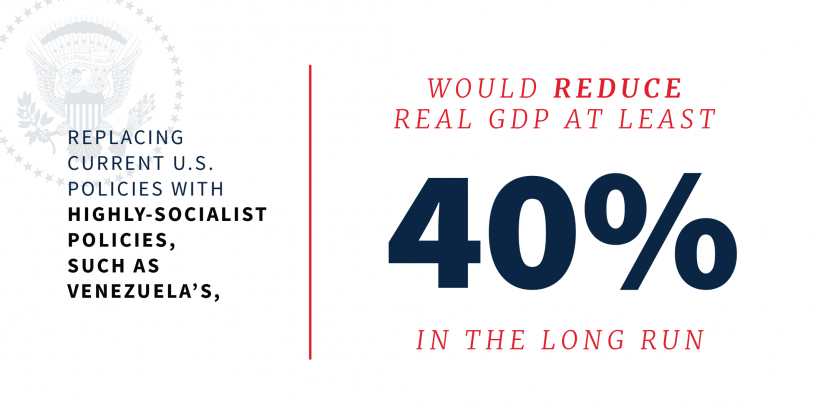
In addition to quantifying the human and economic costs of highly socialist systems, we also estimate the effects of more moderate degrees of socialization. We find that even among market economies, average income and consumption are lower in those with relatively high levels of government taxes and transfers as shares of output—such as Denmark, Sweden, Norway, and Finland—than in the United States. This is because the relatively high average tax rates on middle incomes that finance this “Nordic model” also disincentivize generating income in the first place. Finally, we estimate that if the recent U.S. proposals for socialized medicine in terms of “Medicare for All” were implemented and financed by higher taxes, GDP would decline by 9 percent, or about $7,000 per person, in 2022.
In chapter 9, “Reducing Poverty and Improving Self-Sufficiency in America,” we discuss the impact of the revival of the economy, more specifically on low-income households, and the Trump Administration’s approach to escaping poverty through economic growth and work-based public policies. President Lyndon B. Johnson declared a War on Poverty in January 1964. When using a full-income measure of poverty that is capable of capturing success in the War on Poverty, we find that poverty declined from 19.5 percent in 1963 to 2.3 percent in 2017. This far exceeds the decline from 19.5 to 12.3 percent according to the Official Poverty Measure. However, victory was not achieved by making people self-sufficient, as President Johnson envisioned, but rather through increased government transfers. A new war on poverty should seek to further reduce material hardship based on modern standards, but should do so through incentives to achieve work and self-sufficiency. We discuss the Trump Administration’s important actions along these lines: expanding work requirements for nondisabled, working-age welfare recipients in noncash welfare programs; increasing child care assistance for low-income families; and increasing the reward for working by doubling the Child Tax Credit and increasing its refundability.
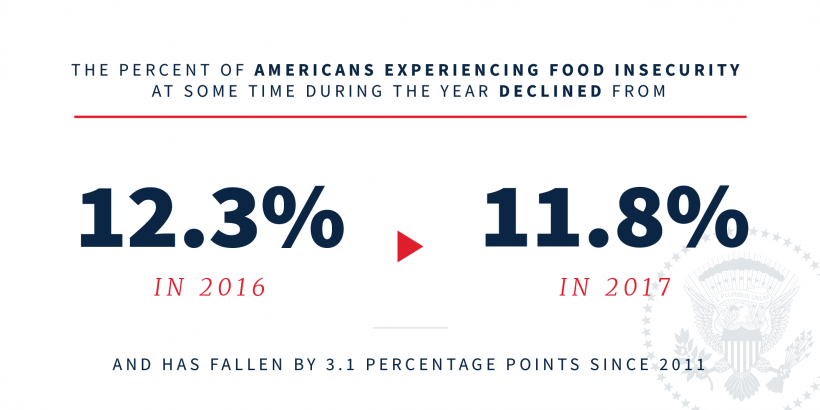
Finally, in chapter 10, “The Year in Review and the Years Ahead,” we analyze important macroeconomic developments in 2018 and present the Trump Administration’s full, policy-inclusive economic forecast for the next 11 years, including risks to the forecast. Overall, assuming full implementation of the Trump Administration’s economic policy agenda, we project real U.S. economic output to grow at an average annual rate of 3.0 percent between 2018 and 2029. We expect growth to moderate, from just over 3.0 percent in 2018 and 2019, as the capital-to-output ratio asymptotically approaches its new, post–corporate tax reform steady state and as the near-term effects of the TCJA’s individual provisions on the rate of growth dissipate into a permanent level effect.
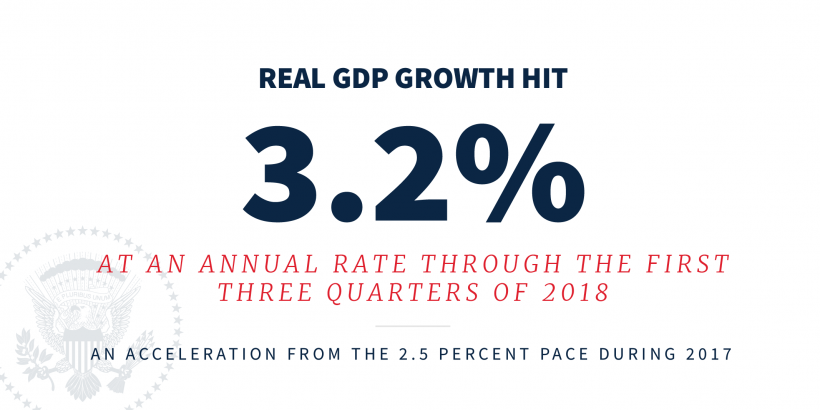
Partially offsetting this moderation are the expected contributions of the supply-side effects of the Trump Administration’s current and future deregulatory actions, as discussed in chapter 2; the permanent extension of the personal income tax provisions of the TCJA, as discussed in chapter 1; and the Administration’s infrastructure proposal, as analyzed in the 2018 Economic Report of the President. In chapter 10, we also explore potential downside risks to the forecast, including nonimplementation, or repeal, of the Trump Administration’s economic policy agenda, slowing economic growth in major economies outside the United States, and the possible adverse economic effects of recent public proposals for “Medicare for All” and a top marginal income tax rate of 70 percent.
Collectively, the 10 chapters that constitute this Report demonstrate that the strong economic performance in 2017 and 2018 constituted a sharp break from the previous pace of economic and employment growth since the start of the present expansion, reflecting the Administration’s reprioritization of economic efficiency and growth over alternative policy aspirations that subordinated growth. We further demonstrate that a unified agenda of tax, regulatory, labor, healthcare, financial, and energy market reforms that enhance the role of market prices is a more efficient and effective approach to unleashing the growth potential of the U.S. economy. The CEA’s mandate under the Employment Act of 1946 is to advise on how best to achieve “maximum employment, production, and purchasing power.”endorsement of free, competitive enterprise relying on market prices to guide economic activity over alternatives demanding increased socialization of productive assets and a consequently diminished role for market prices.
